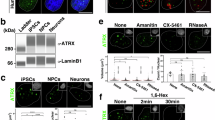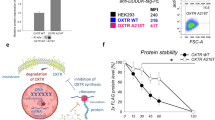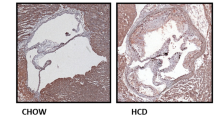Abstract
The Chudley–Lowry syndrome (ChLS, MIM 309490) is an X-linked recessive condition characterized by moderate to severe mental retardation, short stature, mild obesity, hypogonadism, and distinctive facial features characterized by depressed nasal bridge, anteverted nares, inverted-V-shaped upper lip, and macrostomia. The original Chudley–Lowry family consists of three affected males in two generations. Linkage analysis had localized the gene to a large interval, Xp21–Xq26 and an obligate carrier was demonstrated to have highly skewed X inactivation. The combination of the clinical phenotype, consistent with that of the patients with ATR-X syndrome, the skewed X-inactivation pattern in a carrier female, as well as the mapping interval including band Xq13.3, prompted us to consider the XNP/ATR-X gene being involved in this syndrome. Using RT-PCR analysis, we screened the entire XNP/ATR-X gene and found a mutation in exon 2 (c.109C>T) giving rise to a stop codon at position 37 (p.R37X). Western blot and immunocytochemical analyses using a specific monoclonal antibody directed against XNP/ATR-X showed the protein to be present in lymphoblastoid cells from one affected male, despite the premature stop codon. To explain these discordant results, we further analyzed the 5′ region of the XNP/ATR-X gene and found three alternative transcripts, which differ in the presence or absence of exon 2, and the length of exon 1. Our data suggest that ChLS is allelic to the ATR-X syndrome with its less severe phenotype being due to the presence of some XNP/ATR-X protein.
Similar content being viewed by others
Log in or create a free account to read this content
Gain free access to this article, as well as selected content from this journal and more on nature.com
or
References
Chudley AE, Lowry RB, Hoar DI : Mental retardation, distinct facial changes, short stature, obesity, and hypogonadism: a new X-linked mental retardation syndrome. Am J Med Genet 1988; 31: 741–751.
Cole TR, May A, Hughes HE : Alpha thalassaemia/mental retardation syndrome (non-deletional type): report of a family supporting X linked inheritance. J Med Genet 1991; 28: 734–737.
Stevenson RE, Schwartz CE, Schroer RJ : X-Linked Mental Retardation. New York: Oxford University Press Inc., 2000.
Villard L, Gecz J, Mattei JF et al: XNP mutation in a large family with Juberg–Marsidi syndrome. Nat Genet 1996; 12: 359–360.
Abidi F, Schwartz CE, Carpenter NJ, Villard L, Fontes M, Curtis M : Carpenter–Waziri syndrome results from a mutation in XNP. Am J Med Genet 1999; 85: 249–251.
Stevenson RE, Abidi F, Schwartz CE, Lubs HA, Holmes LB : Holmes–Gang syndrome is allelic with XLMR-hypotonic face syndrome. Am J Med Genet 2000; 94: 383–385.
Villard L, Fontes M, Ades LC, Gecz J : Identification of a mutation in the XNP/ATR-X gene in a family reported as Smith–Fineman–Myers syndrome. Am J Med Genet 2000; 91: 83–85.
Lossi AM, Millan JM, Villard L et al: Mutation of the XNP/ATR-X gene in a family with severe mental retardation, spastic paraplegia and skewed pattern of X inactivation: demonstration that the mutation is involved in the inactivation bias. Am J Hum Genet 1999; 65: 558–562.
Gibbons RJ, Bachoo S, Picketts DJ et al: Mutations in transcriptional regulator ATRX establish the functional significance of a PHD-like domain. Nat Genet 1997; 17: 146–148.
Villard L, Lossi AM, Cardoso C et al: Determination of the genomic structure of the XNP/ATRX gene encoding a potential zinc finger helicase. Genomics 1997; 43: 149–155.
Allen RC, Zoghbi HY, Moseley AB, Rosenblatt HM, Belmont JW : Methylation of HpaII and HhaI sites near the polymorphic CAG repeat in the human androgen-receptor gene correlates with X chromosome inactivation. Am J Hum Genet 1992; 51: 1229–1239.
Pegoraro E, Schimke RN, Arahata K et al: Detection of new paternal dystrophin gene mutations in isolated cases of dystrophinopathy in females. Am J Hum Genet 1994; 54: 989–1003.
Bolton BJ, Spurr NK : Culture of immortalized cells; in Freshney RI, Freshney MG (eds): B-Lymphocytes. New York: Weiley-Liss, 1996, pp 283–298.
Cardoso C, Lutz Y, Mignon C et al: ATR-X mutations cause impaired nuclear location and altered DNA binding properties of the XNP/ATR-X protein. J Med Genet 2000; 37: 746–751.
Villard L, Fontes M : Alpha-thalassemia/mental retardation syndrome, X-Linked (ATR-X, MIM #301040, ATR-X/XNP/XH2 gene MIM #300032). Eur J Hum Genet 2002; 10: 223–225.
Plenge RM, Stevenson RE, Lubs HA, Schwartz CE, Willard HF : Skewed X chromosome inactivation is a common feature of X-linked mental retardation disorders. Am J Hum Genet 2002; 71: 168–173.
Garrick D, Samara V, McDowell TL et al: A conserved truncated isoform of the ATR-X syndrome protein lacking the SWI/SNF-homology domain. Gene 2004; 326: 23–34.
Guerrini R, Shanahan JL, Carrozzo R, Bonanni P, Higgs DR, Gibbons RJ : A nonsense mutation of the ATRX gene causing mild mental retardation and epilepsy. Ann Neurol 2000; 47: 117–121.
Gibbons RJ, Higgs DR : Molecular–clinical spectrum of the ATR-X syndrome. Am J Med Genet 2000; 97: 204–212.
Villard L, Toutain A, Lossi AM et al: Splicing mutation in the ATR-X gene can lead to a dysmorphic mental retardation phenotype without alpha-thalassemia. Am J Hum Genet 1996; 58: 499–505.
Villard L, Lacombe D, Fontes M : A point mutation in the XNP gene, associated with an ATR-X phenotype without alpha-thalassemia. Eur J Hum Genet 1996; 4: 316–320.
Stevenson RE, Hane B, Arena JF et al: Arch fingerprints, hypotonia, and areflexia associated with X linked mental retardation. J Med Genet 1997; 34: 465–469.
Brooks SS, Wisniewski K, Brown WT : New X-linked mental retardation (XLMR) syndrome with distinct facial appearance and growth retardation. Am J Med Genet 1994; 51: 586–590.
Miles JH, Carpenter NJ : Unique X-linked mental retardation syndrome with fingertip arches and contractures linked to Xq21.31. Am J Med Genet 1991; 38: 215–223.
Proud VK, Levine C, Carpenter NJ : New X-linked syndrome with seizures, acquired microencephaly, and agenesis of the corpus callosum. Am J Med Genet 1992; 43: 458–466.
Vasquez SB, Hurst DL, Sotos JF : X-linked hypogonadism, gynecomastia, mental retardation, short stature, and obesity – a new syndrome. J Pediatr 1979; 94: 56–60.
Tranebjaerg L, Svejgaard A, Lykkesfeldt G : X-linked mental retardation associated with psoriasis: a new syndrome? Am J Med Genet 1988; 30: 263–273.
McDowell TL, Gibbons RJ, Sutherland H et al: Localization of a putative transcriptional regulator (ATRX) at pericentromeric heterochromatin and the short arms of acrocentric chromosomes. Proc Natl Acad Sci USA 1999; 96: 13983–13988.
Acknowledgements
We would like to express our gratitude to the family for their participation in this study. We would like to thank C Skinner for coordinating sample collection. S Daniels provided sequencing support and T Moss was responsible for maintenance of tissue culture cell lines. This work was supported, in part, by a grant from NICHD (HD26202) to CES, a National Institute of Mental Health Grant (MH57840) to RES and a grant from the South Carolina Department of Disabilities and Special needs (SCDDSN). This work was also supported by a grant from the association pour la recherché contre le cancer (ARC) to MGM. This paper is dedicated to the memory of Ethan Francis Schwartz 1996–1998.
Author information
Authors and Affiliations
Corresponding authors
Rights and permissions
About this article
Cite this article
Abidi, F., Cardoso, C., Lossi, AM. et al. Mutation in the 5′ alternatively spliced region of the XNP/ATR-X gene causes Chudley–Lowry syndrome. Eur J Hum Genet 13, 176–183 (2005). https://doi.org/10.1038/sj.ejhg.5201303
Received:
Revised:
Accepted:
Published:
Issue date:
DOI: https://doi.org/10.1038/sj.ejhg.5201303
Keywords
This article is cited by
-
The ATRX splicing variant c.21-1G>A is asymptomatic
Human Genome Variation (2022)
-
Targeting G-quadruplex DNA as cognitive function therapy for ATR-X syndrome
Nature Medicine (2018)
-
The role of genetics in the establishment and maintenance of the epigenome
Cellular and Molecular Life Sciences (2013)
-
Genetic syndromes caused by mutations in epigenetic genes
Human Genetics (2013)
-
Alpha-Thalassämie-Retardierungs-Syndrom
Monatsschrift Kinderheilkunde (2010)



